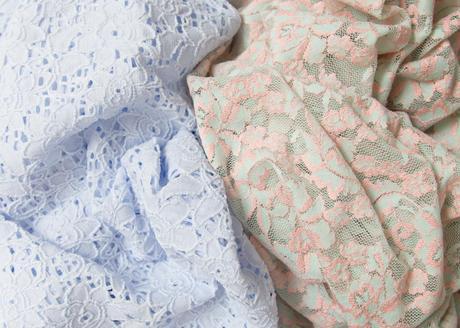
Before giving bra making a go, it’s important to have a firm understanding of how each part of a bra should function – cup, cradle and wing – because this is what will guide you when making fabric choices. Many sewers get stalled even before starting because selecting different fabrics for each section is too daunting. Stretch lace for the front? Power net for the back? Tricot for the lining? Contrary to what many beginners think, both woven and knits can be used to make a bra, and hopefully after reading this, you’ll be comfortable and confident to choose either.
First concept to understand is direction of greatest stretch, abbreviated DOGS. In a woven fabric, grainline is used to indicate the direction that has the least amount of stretch, and in most cases, patterns are aligned with this line. In bra making, patterns are cut according to the direction of greatest stretch (DOGS). So, when you’re looking at a bra pattern, lines with arrows indicate the DOGS, not the grainline. To find the DOGS on your fabric, pull on the lengthwise and crosswise. What has more stretch? That is the DOGS. On stretch fabrics, there is either a stretch in one direction, called a 2-way stretch, or a stretch in all directions, called a 4-way stretch.
With this understood, let’s walk through the parts of a bra and its function.
Band: The band must have stretch running around the body because if not, there will be no room to breath. So, the DOGS is perpendicular to the hook and eye. Also to note, the band
is not stabilized in most cases (the bridge and cups are).
Bridge: The bridge must be stable from side to side and from top to bottom. Why? Because the bridge is where the bra’s support comes from. While we allow the back to stretch for breathing, we stabilize the front so that it can support the breasts, which sit right above it. The bridge is stabilized in two ways. First, the DOGS is placed parallel to the center front, then the bridge is interfaced with tricot, fusible or something similar.
Cups: The placement of the DOGS on the cup depends on the type of support desired, and that’s a whole other post in itself. You can change the direction of the DOGS to meet a particular need, but in most cases, the DOGS on a horizontal, cross cup seam is parallel to the neckline on the upper cup and perpendicular to the cross cup seam on the lower cup.
Now, let’s match the performance with fabric.
Band: Remembering that the band is supposed to stretch, choose a stretch fabric such as
powernet, lycra, stretch lace, etc.
Bridge: The bridge can be either a woven or a stretch fabric. Duoplex, Simplex, woven cotton, woven silk, satin, or lace are popular rigid fabrics, and stretch lace is a popular stretch fabric. Whether the bridge is a woven or a stretch, remember that it will need to be stabilized with a lining or a fusible interfacing.
Cups: Just like the bridge, the cups can be made with woven or stretch fabric, and it depends on the type of support desired. The recommended fabrics are the same as the bridge. The fabric of the bridge and the cups can match, or they can be a different fabric to add contrast.

